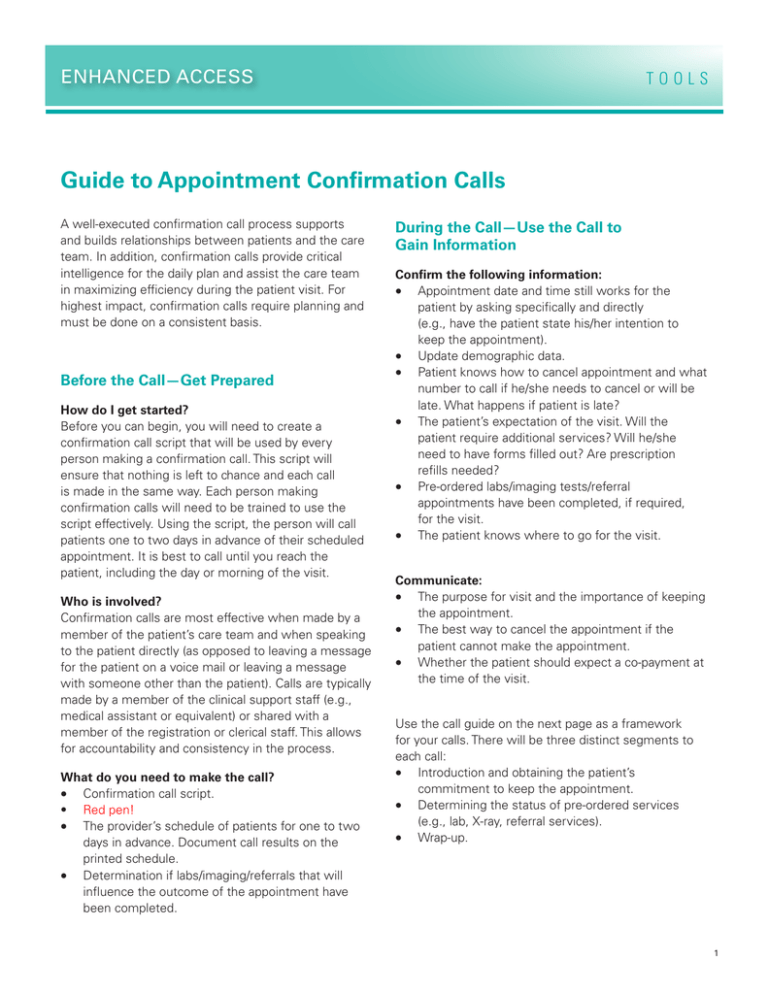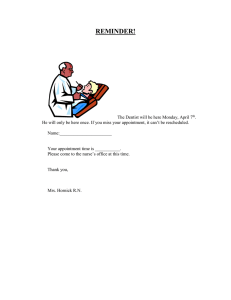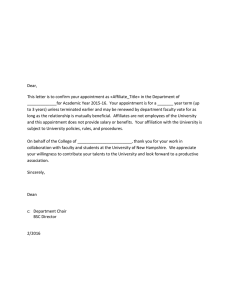Guide to Appointment Confirmation Calls
advertisement

ENHANCED ACCESS TOOLS Guide to Appointment Confirmation Calls A well-executed confirmation call process supports and builds relationships between patients and the care team. In addition, confirmation calls provide critical intelligence for the daily plan and assist the care team in maximizing efficiency during the patient visit. For highest impact, confirmation calls require planning and must be done on a consistent basis. Before the Call—Get Prepared How do I get started? Before you can begin, you will need to create a confirmation call script that will be used by every person making a confirmation call. This script will ensure that nothing is left to chance and each call is made in the same way. Each person making confirmation calls will need to be trained to use the script effectively. Using the script, the person will call patients one to two days in advance of their scheduled appointment. It is best to call until you reach the patient, including the day or morning of the visit. Who is involved? Confirmation calls are most effective when made by a member of the patient’s care team and when speaking to the patient directly (as opposed to leaving a message for the patient on a voice mail or leaving a message with someone other than the patient). Calls are typically made by a member of the clinical support staff (e.g., medical assistant or equivalent) or shared with a member of the registration or clerical staff. This allows for accountability and consistency in the process. What do you need to make the call? • Confirmation call script. • Red pen! • The provider’s schedule of patients for one to two days in advance. Document call results on the printed schedule. • Determination if labs/imaging/referrals that will influence the outcome of the appointment have been completed. During the Call—Use the Call to Gain Information Confirm the following information: • Appointment date and time still works for the patient by asking specifically and directly (e.g., have the patient state his/her intention to keep the appointment). • Update demographic data. • Patient knows how to cancel appointment and what number to call if he/she needs to cancel or will be late. What happens if patient is late? • The patient’s expectation of the visit. Will the patient require additional services? Will he/she need to have forms filled out? Are prescription refills needed? • Pre-ordered labs/imaging tests/referral appointments have been completed, if required, for the visit. • The patient knows where to go for the visit. Communicate: • The purpose for visit and the importance of keeping the appointment. • The best way to cancel the appointment if the patient cannot make the appointment. • Whether the patient should expect a co-payment at the time of the visit. Use the call guide on the next page as a framework for your calls. There will be three distinct segments to each call: • Introduction and obtaining the patient’s commitment to keep the appointment. • Determining the status of pre-ordered services (e.g., lab, X-ray, referral services). • Wrap-up. 1 ENHANCED ACCESS Purpose of Statement Call Script Introduction and Commitment to Keep Appointment Introduce yourself. “Good morning (afternoon, evening), this is Janie, Dr. Welby’s nurse, calling from Goodwill Clinic. I am calling to confirm your appointment on Tuesday at 10 am. Are you intending to keep Obtain patient’s this appointment?” commitment to keep the appointment. If patient is non-committal (“thinks” he/she can make it, press for commitment). TOOLS Comments/Action Listen carefully to patient’s response and how he/she says it. “Are you sure? If this is no longer a good time I Then do it and re-code this now can make an appointment for you later this week rescheduled appointment slot or next.” for a walk-in or same day slot. Determine Status of Pre-Ordered Services If patient’s pre-ordered labs/imaging/referral has not been completed (by record review). “Good Morning (afternoon, evening), this is Janie, Dr. Welby’s nurse, calling from Goodwill Clinic.” “You have an appointment scheduled for Thursday at 10 am, and I see that [lab/imaging tests/ referral] were ordered to be done before this visit. We don’t have those results back yet. Have they been completed?” If completed, initiate follow-up to get results from source. If not completed, ask for the date that they will be completed and reschedule the appointment to follow the receipt of those results. Recode this now vacated appointment slot as a same day slot. Wrap-Up Confirm address/phone number. “Please confirm your address and the best phone number for Dr. Welby to reach you.” Update information in the patient record and on the printed schedule sheet. Determine other needs for the upcoming appointment to help the care team prepare. “I see that the purpose for your visit is X, is there anything else that you will need during this appointment?” (e.g., medication refills, forms completed). Document these additional needs on the printed schedule sheet. Review clinic address, parking, and check-in process. “We’re located at 1234 B Street on the 2nd floor. Free parking is available. You can check in on the 1st floor. ” 2 ENHANCED ACCESS Purpose of Statement Call Script TOOLS Comments/Action Wrap-Up Continued Review co-payment requirements. “Your co-payment will be $10. Please bring a copy of your new insurance card.” Review pre-visit instructions. ”Be sure to bring in your medication list and your list of blood pressure readings.” Review process for cancellation. State why the clinic needs to know if the patient cancels. “If you are running late or need to cancel or reschedule (even on the day of your appointment), please call me at 555-1234 and I can reschedule you. Dr. Welby uses the cancellations to fit in other patients who need immediate care.” After the Call—Take Notes for the Care Team Using the printed schedule, makes notes to document the result of each call that is made to a patient. Information noted on the printed schedule can then be transferred to the huddle sheet and shared with the care team. Develop a color-coding scheme and use colored highlighters to indicate call results, or develop a list of abbreviations for this purpose. Below are examples of call result notations that could be recorded on the schedule: PC Reached patient; patient confirmed RXL Reached patient; patient cancelled RRS Reached patient; patient rescheduled VM Left a voice message at patient’s number MSG wife Left a message with someone other than patient (note whom the message was left with). NA X3 No answer; indicate number of call attempts DISC Phone number disconnected Calls denoted as “cancelled” or “rescheduled” are now available for use as “same day access” appointment slots. Source: Adapted from materials developed by Primary Care Development Corporation and Coleman Associates, 2006-2007; Neal R, et al. 3 ENHANCED ACCESS TOOLS Safety Net Medical Home Initiative This is a product of the Safety Net Medical Home Initiative, which was supported by The Commonwealth Fund, a national, private foundation based in New York City that supports independent research on health care issues and makes grants to improve health care practice policy. The views presented here are those of the author and not necessarily those of The Commonwealth Fund, its directors, officers, or staff. The Initiative also received support from the Colorado Health Foundation, Jewish Healthcare Foundation, Northwest Health Foundation, The Boston Foundation, Blue Cross Blue Shield of Massachusetts Foundation, Partners Community Benefit Fund, Blue Cross of Idaho, and the Beth Israel Deaconess Medical Center. For more information about The Commonwealth Fund, refer to www.cmwf.org. The objective of the Safety Net Medical Home Initiative was to develop and demonstrate a replicable and sustainable implementation model to transform primary care safety net practices into patient-centered medical homes with benchmark performance in quality, efficiency, and patient experience. The Initiative was administered by Qualis Health and conducted in partnership with the MacColl Center for Health Care Innovation at the Group Health Research Institute. Five regions were selected for participation (Colorado, Idaho, Massachusetts, Oregon and Pittsburgh), representing 65 safety net practices across the U.S. For more information about the Safety Net Medical Home Initiative, refer to: www.safetynetmedicalhome.org. 4



